November 11, 2022
Air Date: November 11, 2022
FULL SHOW
SEGMENTS
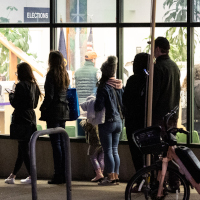
Climate at the Ballot Box
/ Peter DykstraView the page for this story
Host Steve Curwood and Environmental Health News’ Weekend Editor Peter Dykstra take a look at the 2022 midterms to analyze incoming Governors, outgoing Senators, and the only two ballot initiatives on climate. (09:34)
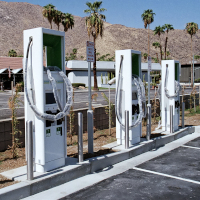
Climate Action Winner in the Golden State
View the page for this story
California Democratic Governor Gavin Newsom handily won re-election and now has 4 more years to work towards his goal of achieving carbon neutrality in the state by 2045. Mr. Newsom and other Governors have billions of dollars in climate funding at their disposal that was allocated by the U.S. Congress this summer. These state governments will play a crucial role in helping cities, universities, and the private sector make the most of it. Lauren Sanchez, Senior Climate Advisor to Governor Newsom, joins Host Steve Curwood for a look at California’s top climate priorities and how the Golden State intends to lead on climate amid an uncertain national political landscape. (14:36)
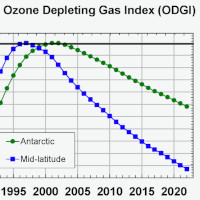
Ozone-Killing Chemicals Declining
View the page for this story
Emissions of chemicals that tear holes in the protective atmospheric ozone layer have been drastically reduced, thanks to the Vienna Convention launched in 1985 and its related Montreal and Kigali protocols. NOAA recently reported that midlatitude atmospheric concentrations of ozone depleting chemicals have declined about 50% compared to peak historic levels. Steve Montzka, senior scientist at the NOAA Global Monitoring Laboratory, joins Host Steve Curwood to explain how the global community reached this milestone. (08:13)

Extreme Wildlife Loss
View the page for this story
This year’s Living Planet Report from the World Wildlife Fund and Zoological Society of London shows a nearly 70% decline in wildlife populations since 1970 due to habitat loss, over harvest, pollution, climate stress and more. The climate crisis will keep putting even more pressure on wildlife but there are also signs of improvement and hope. Host Steve Curwood discusses the report and how we can restore the loss with WWF Global Freshwater Lead Scientist Jeff Opperman. (13:56)
Show Credits and Funders
Show Transcript
221111 Transcript
HOSTS: Steve Curwood
GUESTS: Steve Montzka, Jeff Opperman, Lauren Sanchez
REPORTERS: Peter Dykstra
[THEME]
CURWOOD: From PRX – this is Living On Earth.
[THEME]
CURWOOD: I’m Steve Curwood.
As we go to air the balance of power in the U.S. Congress is uncertain, but climate-friendly Governors in California and elsewhere are going full speed ahead.
SANCHEZ: The state plays a critical role in supporting cities and schools, farmers, our innovative clean businesses in accessing those funds and making sure the communities most in need benefit first and foremost from those funds.
CURWOOD: Also, a nearly 70 percent decline in wildlife over the last 50 years and how to reverse it.
OPPERMAN: Climate crisis and the nature crisis are two sides of the same coin. Two sides of the same coin in terms of the drivers of the crises, but also two sides of the coin in terms of solutions, that if we can protect and restore tropical forest, we can be addressing both the nature crisis and the climate crisis.
CURWOOD: That and more this week on Living on Earth – Stick Around!
[NEWSBREAK MUSIC: Boards Of Canada “Zoetrope” from “In A Beautiful Place Out In The Country” (Warp Records 2000)]
[THEME]
Climate at the Ballot Box
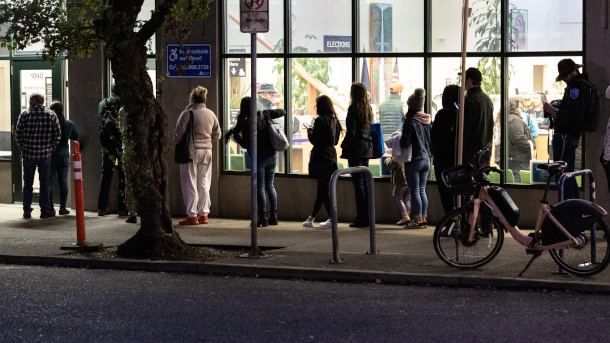
Voters stand in line in the dark outside a ballot drop-off location in Oregon. (Photo: MultCo Communications, Flickr, CC BY-NC-ND 2.0O
CURWOOD: From PRX and the Jennifer and Ted Stanley Studios at the University of Massachusetts Boston, this is Living on Earth. I’m Steve Curwood.
However the balance of power in Congress ends up as a result of the midterm elections, President Joe Biden is making one thing clear. He will block any efforts to repeal the sweeping climate measures in the Inflation Reduction Act with his veto pen.
BIDEN: I'm not going to walk away from historic commitments we just made to take on the climate crisis. They're not compromisable issues to me. And I won't let it happen.
CURWOOD: And the President sees the election results as a mandate for him to stay the course.
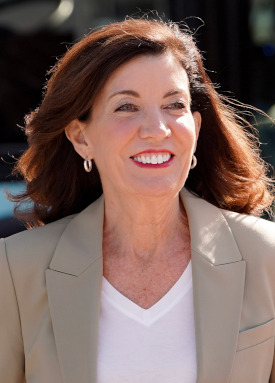
Kathy Hochul took office as governor of New York after Andrew Cuomo resigned in 2021, and she has just won her first full term in the 2022 midterms. (Photo: Marc A. Hermann, MTA, Wikimedia Commons, CC BY 2.0)
BIDEN: On this election season, the American people made it clear they don't want every day going forward to be a constant political battle. There's too much that of that going on. There's too much we have to do. The future America is too promising, too promising to be trapped in an endless political warfare.
CURWOOD: And Democrats did do better than expected in the mid-terms, though not all the final results are in yet. So, to take a look at the impact of the mid-terms so far we turn now to Peter Dykstra, an editor with Environmental Health News, that’s ehn.org and dailyclimate.org. He is with us now on the line from Atlanta, Georgia, in one of the states that has yet to settle on its US senate seat. Hi there, Peter!
DYKSTRA: Well, hi Steve. We have a runoff in the race for the Senate between Reverend Raphael Warnock and Herschel Walker, the football legend from the University of Georgia. That won't be decided until an election on December 6.
CURWOOD: And there are other Senate seats up in the air. What, I'm thinking of Arizona and Nevada as we speak, I'm not sure that those have been settled. And who knows, maybe won't even know about those until after this runoff.

Gretchen Whitmer, Governor of Michigan (Photo: City of Detroit, Wikimedia Commons, public domain)
DYKSTRA: We shall see. It's a hard fought, and not necessarily by any standard, a clean race, that the parties and the big funders have spent millions on. The Atlanta Journal Constitution ran the numbers on the Warnock and Walker race, and found that a quarter billion dollars has been spent on behalf of the two candidates.
CURWOOD: Wow. Imagine if that went to direct constituent services for the people of Georgia.
DYKSTRA: Oh, I'll take some.
CURWOOD: Peter, whichever parties ended up controlling the houses of Congress, it looks like Joe Biden is going to be safe in terms of being able to veto any attempts by the Republicans to roll back things like the Inflation Reduction Act to deal with the climate or the infrastructure measures, or things like that. The pundits, though, and a lot of the polls seem to think that it was going to be a much better day for the Republicans. What do you think they got wrong? What's with the punditry here?
DYKSTRA: Well, gotta remember that pundits are not necessarily right. And they're actually spectacularly wrong a lot of the time. If you go through punditry for most of the year 2016, you'll learn that there's no way that Donald Trump would ever be elected President of the United States. And of course he was and thinks he still is.
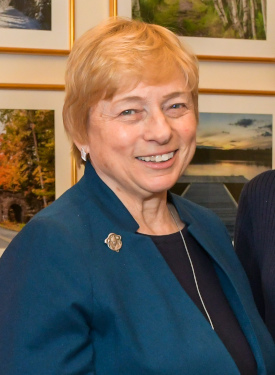
Janet Mills, Governor of Maine (Photo: Rebecca Hammel, US Senate, Public Domain)
CURWOOD: Indeed. Now, what about the climate? How did it play, Peter? I mean, we saw some exit polling data that suggested in a number of places, the climate was just number three, as a top concern issue behind the economy and I think one case abortion and another case, immigration. How was it reflected in the election, do you think?
DYKSTRA: It was very, very scant, in terms of any mentions at all, in climate advertising, that I've seen about the candidates, and also very scant in terms of how it was in speeches, debates, anything. And what I found appalling, in my own opinion, was that the state of Florida, whose majority population by the end of the century or earlier, is right now living on what will be on inhabitable land underwater, including the primary residences of Marco Rubio, who won the Senate race, and Ron DeSantis, who won the governor's race, both for reelection. And those two, among millions and millions of other Floridians, based on the polls and the election results don't seem to be overly concerned about coming up with a solution to climate change and sea level rise.
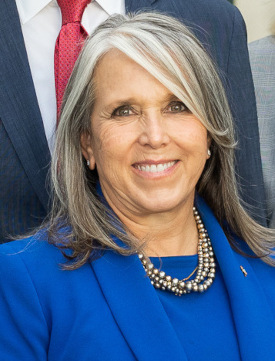
Michelle Lujan Grisham, Governor of New Mexico (Photo: Adam Schultz, White House, public domain)
CURWOOD: We've been talking, of course, about the congressional elections. And you mentioned the governor though, there in Florida, but a number of other governors who are more interested, I think, in dealing with the climate were either reelected or elected. Let's talk about those for a moment.
DYKSTRA: Well, yeah, there are governors who were reelected, after showing some pretty strong enthusiasm for dealing with climate change. They include Gavin Newsom of California, Kathy Hochul of New York State, Gretchen Whitmer of Michigan. Other governors like Mills of Maine, Lujan Gresham of New Mexico, and a couple of newcomers, Wes Moore of the state of Maryland and Maura Healey of Massachusetts.

Wes Moore, Governor-elect of Maryland (Photo: Amunankhra House Ltd., Wikimedia Commons, CC BY 3.0)
CURWOOD: And I guess as long as the Inflation Reduction Act stays in place, those governors are going to be able to tap considerable financial resources, I'd say Peter, right?
DYKSTRA: They could, as could other people at the state cabinet levels, state environment agencies, and others. Of course, there are other governors and other state cabinet officials in conservative states that might want to resist any federal assistance with climate change money, the way many of them resisted extra Medicaid money when that was broadened a few years ago.
CURWOOD: Yeah, we'll have to follow up on that. Hey, in the meantime, where was the environment actually on the ballot?
DYKSTRA: That's the other surprising thing. There were only two really substantial ballot initiatives this year. One was in New York State. It was a whopping $4.2 billion.
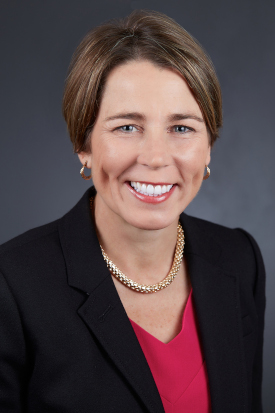
Maura Healey, Governor-elect of Massachusetts (Photo: Massachusetts Attorney General, public domain)
That's a lot for an individual state to help clean energy and other technologies. It included $500 million to electrify school buses. There's also $400 million in this New York ballot item for green building projects. Over a billion for restoration and protection of areas that help cut down on flood risk. That would have been a nice thing to have when Superstorm Sandy hit New York City and Long Island and also hit New Jersey, almost 10 years ago, to the day. And of course, it was a multibillion dollar storm with a tragic death toll that happened late in the year of 2012. There's also more conservation money, preservation of open space. All of that was passed by New York state voters. There was another initiative with a lot of promise in California. That wasn't passed by California voters. California Proposition 30 would tax income levels above 2 million to help fund programs for zero emission vehicles and also fund wildfire prevention efforts. Of course, California, every year in recent years, has run out its wildfire budget because wildfires driven by climate change have increased.
CURWOOD: But I guess California voters decided they didn't want to go along with that.
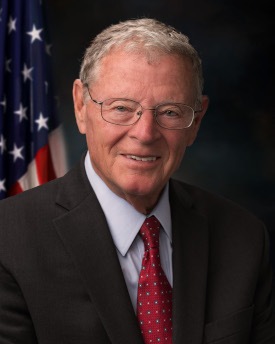
Retiring Senator Jim Inhofe (R-OK) (Photo: United States Senate Photography, Public Domain)
DYKSTRA: That's correct.
CURWOOD: Hey, let's go back to the Congress for a moment, because I think there's some important retirements that are coming up.
DYKSTRA: Oh, yeah. One of my favorites is Senator Jim Inhofe. For years he has been the bull moose, the alpha dog of climate denial. He has said many times that climate science is a hoax. He's going to be quitting. His 88th birthday is next week. The Senator and I have an appointment to talk on the record on his 100th birthday on November 18, 2034. And he and I are going to check out how his claims of a climate hoax are working out.
CURWOOD: Maybe he just couldn't quite see what was going on with the climate, Peter, huh?
DYKSTRA: No, but another senator who did served 48 years. That's Patrick Leahy of Vermont, also the biggest Grateful Deadhead in the Senate.
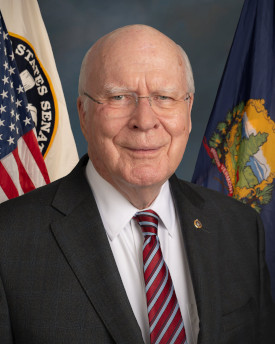
Patrick Leahy, the current president pro tempore of the United States Senate, will be retiring after he did not seek reelection in the 2022 midterms. (Photo: Renee Bouchard, U.S. Congress, Wikimedia Commons, public domain)
He's been there since the 70s. Leahy has fought the battle to restrict acid rain emissions among many other things. He's got a strong environmental record and his leadership is going to be missed in the United States Senate for many years to come.
CURWOOD: Right. And for many of those years, he was President Pro Tem, which put him fourth in line for the presidency if something had happened. Well, thanks, Peter. Peter Dykstra is an editor with Environmental Health News, that's ehn.org and dailyclimate.org. Thanks on this and we'll catch up with you to see how that thing is going on in Georgia and that runoff election in the weeks ahead.
DYKSTRA: All right, Steve, thanks a lot and we'll talk to you soon.
CURWOOD: And there's more on the stories on the Living on Earth webpage. That's LOE.org.
Related links:
- The Sierra Club | “What the Midterm Election Results Mean for Climate Action and the Environment”
- Read Peter Dykstra’s article on the 2022 midterm elections here
[MUSIC: Lionel Hampton, Stan Getz, “Louise” on Hamp & Getz, The Verve Music Group]
CURWOOD: Coming up – California Governor Gavin Newsom just won a strong vote of confidence at the polls. The Golden State’s ambitious climate agenda is just ahead. Stay tuned to Living on Earth.
ANNOUNCER: Support for Living on Earth comes from Sailors for the Sea and Oceana. Helping boaters race clean, sail green and protect the seas they love. More information @sailorsforthesea.org. Support also comes from Friends of Smeagull the Seagull and Smeagull’s Guide to Wildlife. It’s all about the wildlife right next door to you! That’s Smeagull, S - M - E - A - G - U - L - L, SmeagullGuide.org.
[CUTAWAY MUSIC: Lionel Hampton, Stan Getz, “Louise” on Hamp & Getz, The Verve Music Group]
Climate Action Winner in the Golden State
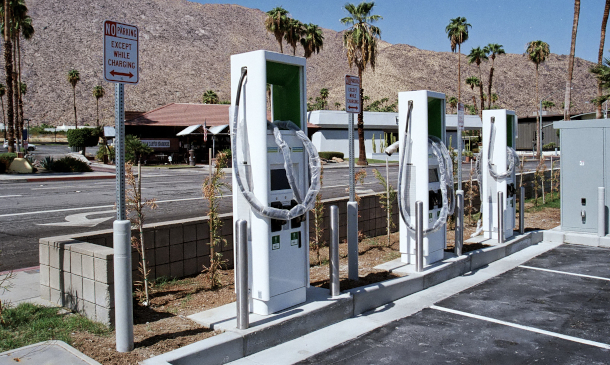
A new electric vehicle charging station in the Coachella Valley, California. As of November 2022, 18% of the new vehicles sold in the state are electric vehicles. (Photo: Ron Gilbert, Flickr CC BY-ND 2.0)
CURWOOD: It’s Living on Earth, I’m Steve Curwood.
California Democratic Governor Gavin Newsom handily won re-election and now has four more years to work towards his goal of achieving carbon neutrality in the state by 2045. Now, it won’t be easy or cheap. But Uncle Sam is providing a big down payment, with the $370 billion for climate in the Inflation Reduction Act passed by the U.S. Congress this summer. Now it’s up to state governments like California’s to dole out that money and help cities, universities, and the private sector make the most of it. Joining us now to discuss climate action in the Golden State is the Senior Climate Advisor to Governor Newsom, Lauren Sanchez. Welcome to Living on Earth!
SANCHEZ: Thanks so much for having me, Steve.
CURWOOD: It's our pleasure. So Governor Newsom has four more years and a clear mandate from the electorate to move ahead with the state's ambitious climate policy. What's the top priority around dealing with climate change in California?
SANCHEZ: Well, Steve, I just want to start with, you know, I'm so grateful to be in a state that has so many people across the political spectrum, and across the state for whom climate change is really a top issue. That is what has allowed California to be a leader in this space, really for decades. We've had three bipartisan governors who have continued to lead on this agenda, you know, unlike the political seesaw of our federal government. And in my role, when I travel around the state, I visit neighborhoods where there's oil drilling next to daycares, or talk to moms about protecting their kids from our heat waves, or traveling firsthand to see some of our devastating wildfires in the Sierra, it is clear that this is really a top issue for all Californians. We have a long history of kind of setting bold climate goals in California, our 2020, 2030 climate targets. And just a few months ago, the governor actually worked with the legislature to enact a new suite of world-leading climate legislation. You mentioned our carbon neutrality by 2045 goal. But now we also need to achieve 90% clean energy by 2035. And we've made big advancements in carbon removal, and nature-based solutions. And this is all to say, our big top priority for our next term will be turning those big goals into action, really turning promises into solutions and benefits for communities. We call it the era of implementation. You know, historically, we've cut our carbon pollution while growing the economy, and that's what, you know, states and countries really around the world are looking for. They're all gathered in Egypt right now at the annual UN conference. And Steve, earlier in my career, I actually helped President Obama negotiate the Paris Agreement, lived and breathed the UN climate process. But it was really an easy decision to stay here in California this week with the governor, because it's clear that he means action. Not the big lofty goals and talking, but his commitment to our clean energy revolution is really what the movement needs right now. So our commitment to implementation over the next four years, to delivering the innovation and the tools that the state needs to achieve those climate goals, is really going to be our top priority.
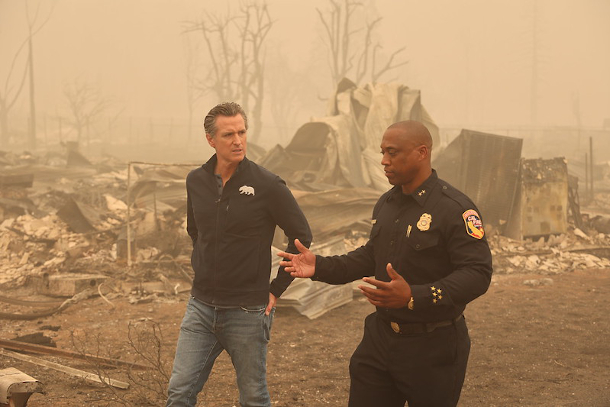
Governor Gavin Newsom and CAL FIRE Chief Curtis Brown survey the devastation of the 2021 Dixie Fire in Greenville, California. (Photo: CAL FIRE_Official, Flickr, CC BY-NC 2.0)
CURWOOD: So where do you start now? You've got these four years clear ahead, you've got this strong mandate, the emergency is with us, we know. There are a lot of things to do, but you can't do everything at once. What's at the top of the list right now?
SANCHEZ: So about half of our climate pollution comes from the transportation sector in California. And if listeners have visited the state, they know why: We have 30 million cars on the road, a big state, and a long history of car culture. The governor really made it a top priority to accelerate all of our efforts to make sure that we are leaving the tailpipe behind, really ending combustion in our vehicles and moving towards 100% sales of electric vehicles by 2035. You know, Steve, he issued an executive order halfway through the first term, setting out that goal. And then just a few months ago, the Air Resources Board enacted that goal into law. We just passed $10 billion in a package for zero emission vehicles, specifically subsidies and incentives for lower income Californians to be able to get into those cleaner cars. We are at about 18% of sales right now are EVs in the state, we have half of the nation's clean cars here in California. And this is a big priority for us if we're going to achieve carbon neutrality and these other ambitious goals. I would also say as we think about climate change, and just the economic opportunity that it offers Californians and communities around the state, you know, we have 43 manufacturers of EVs here in the state, we have six times as many clean energy jobs as fossil fuel jobs. You know, building the clean energy revolution and the clean electric vehicle revolution here in state is going to lift up so many communities, deliver good jobs, and really allow California to continue dominating as one of the world's largest economies.
CURWOOD: So you have a highway towards climate progress in California. What challenges or obstacles are you seeing? What's going to be the, one of the toughest nuts for you guys to, to crack to move these ambitious policies forward?
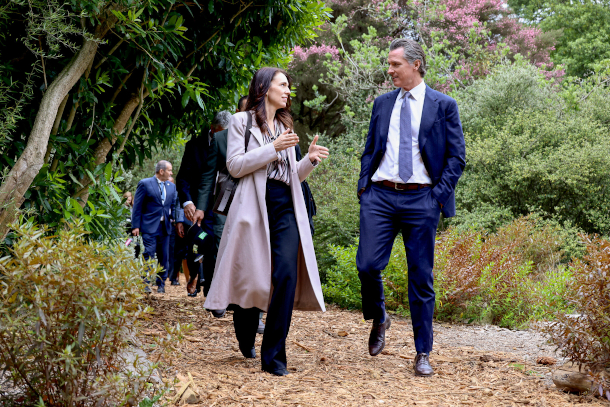
California Governor Gavin Newsom and New Zealand Prime Minister Jacinda Ardern in the New Zealand Garden at the San Francisco Botanical Garden in Golden Gate Park, where the two leaders established a new international climate partnership outlining common objectives to achieve carbon-neutrality by mid-century and more. (Photo: Office of the Governor of California, Flickr, CC BY-NC-ND 2.0)
SANCHEZ: Well, Steve, one of the biggest challenges we have is really just the urgency, the speed with which we need to transform the world's now fourth largest economy. You know, when I started my career in climate change, we often talked about the impacts we would be dealing with in 2050 or in 2100. And here in California, there are impacts we're dealing with today. I mean, I think your listeners are probably very familiar with the devastating images of wildfires, the historic drought we're in, we broke a thousand heat temperatures during our heatwave in September. I mean, these are, we are confronting the realities of this crisis day in and day out. So we know that we are going to continue leading the world on reducing carbon pollution. But we also are spending a lot of time protecting those most vulnerable communities here in state. I would also say, you know, climate used to be seen as an environmental issue, but it isn't. It's really an all of society issue. And the only way we're going to achieve that urgency for our 2030 goals and our 2045 goals is by really mobilizing an all of society movement across this state, to get the clean energy built, and the clean infrastructure built, the affordable transit that we know we need. But Steve, I'd also take a moment, you know, we're fighting an existential battle right now against some of the big polluters here in California. That climate legislative package that I mentioned earlier was fought really hard by Big Oil, who has, you know, a tremendous amount of historic political power here in the state. And the governor and the legislative leaders stood with communities against Big Oil, and won that fight. But now we know that they're filing a referendum to overturn some of those laws, and to continue polluting our communities and polluting the planet; while, I'll mention, raising gas prices, an incredibly important political issue here in California. The governor has called for a special legislative session to enact a windfall profit tax. We saw record quarter three profits from the big oil companies last quarter, as, you know, Californian families are struggling at the gas pumps. I will say some of the big oil companies have seen the writing on the wall and are working constructively with us on a clean energy future, whether it's green hydrogen, or shifting towards building electric vehicle charging at those stations, and we're excited to partner with our industry partners on the clean energy future that we can all believe in. So hopefully, we'll have future partners on this battle going forward.
CURWOOD: Now, there's billions of dollars that the Inflation Reduction Act makes available for states to put towards low carbon and resiliency projects. How is the governor's office there in California gonna help the cities, towns, universities, counties, and the private sector leverage those funds?
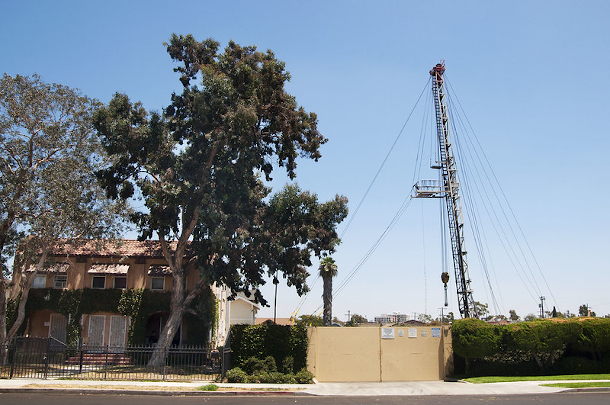
An oil rig in a south Los Angeles neighborhood. In September 2022 Governor Newsom signed into a law a provision banning new oil drilling within 3,200 feet of homes, schools, parks, or businesses open to the public, and setting pollution limits for existing wells within that boundary. (Photo: Sarah Craig/Faces of Fracking, Flickr, CC BY-NC-ND 2.0)
SANCHEZ: Well, Steve, President Biden deserves a lot of credit for getting the Inflation Reduction Act across the finish line. And I'm really grateful that John Podesta, a tremendous leader and partner, is really at the helm of implementing those critical funds from the federal government. I think we think of victory as getting the legislation passed. And I'll tell you, I was incredibly happy that we were able to get it passed! But here in California, we think of victory as getting those funds to Californians and really Americans across the country so that they can save money on their energy bills, they can reduce carbon pollution, and really be a part of our movement. The state plays a critical role in supporting cities and schools and farmers, our innovative clean businesses, in accessing those funds, and importantly, making sure that the communities most in need benefit first and foremost from those funds.
CURWOOD: Talk to me about the priority list in terms of advancing environmental justice. I know at times the cap and trade program California's had has been criticized because polluters near low-income neighborhoods, often of color, get the pollution while the credits go elsewhere. What do you see as the top priority to advance environmental justice in California now?
SANCHEZ: Well, Steve, Governor Newsom's climate plan really starts and ends with communities. If you look around the state, around the nation, and you look for a polluting facility: a port, an incinerator, or refinery, you'll find a low-income community or community of color next door. That's the environmental justice we're fighting day in and day out. What we're trying to do, really across the government, through resources, through access to policymaking and decision makers, through legislation, is empower those communities, to lift them up. Because fundamentally, we all deserve equal access to clean air and a healthy environment. I'm proud to be a part of the Newsom administration where, throughout the first term, we were able to advance a number of environmental justice communities and priorities of our community partners whether it was access to safe and affordable drinking water, protecting communities from toxic pollution, or ending harmful neighborhood oil drilling. So one of the bills we were able to pass this year that has failed in previous legislative sessions is building a buffer between oil drilling and sensitive receptors: homes, schools, daycares; a 3200 foot health buffer to protect communities from what we know are incredibly harmful health impacts of oil drilling. That law was passed, there's a referendum now filed to overturn it. The law actually begins implementation on January 1 of next year. So our entire agencies are really focused on how we can get that law in place so that, you know, we end this really harmful practice of drilling next to daycares. And make sure that you know, when you drop your kids off at school, you don't see an oil rig polluting them, giving them asthma, cancer, etc. So continuing to fight for that and implement that law in an equitable way will continue to be a top environmental justice priority for us.

Lauren Sanchez is Governor Gavin Newsom’s Senior Climate Adviser. (Photo: Courtesy of Lauren Sanchez)
CURWOOD: Lauren, how can California and Governor Newsom partner with and lead other pro-climate protection states and governors on these issues? I'm thinking of Maura Healey of Massachusetts, Wes Moore has won in Maryland, Gretchen Whitmer has won reelection, among others, and actually the Canadian provinces for that matter as well.
SANCHEZ: Well, Steve, I have to say, even as you read off that list of victories this year, there's, I just feel a tremendous sense of solidarity. You know, California is 1% of global climate emissions. We can't do this alone. We have built partnerships with other nations and states and provinces over the last few years, and really been able to share what has worked in California, and what we've learned from what hasn't worked. But we also want to learn from others. You know, I could point to any one of those states and I think there are a number of things that they're doing where they're ahead of us. I do think the urgency and the solidarity that is required on this issue means we need partners all around the country. I'd also point to, Steve, the US Climate Alliance, a group of 24 bipartisan governors who came together during the Trump administration, really to fight back against everything the federal government was doing. Now, we're in an exciting, I would say, discussion around, depending on how Congress shakes out in the next few weeks, we know that states are going to continue to play a really important role in ensuring we move forward as a nation despite what is happening in DC. The governor co-chairs that alliance and will continue to play an important leadership role.
CURWOOD: The climate emergency is existential, it's huge. You guys have fires, we're looking at crazy storms. And we really almost seem like we're out of time to deal with it. What gets you up in the morning to do this work?
SANCHEZ: Well, Steve, one of the most inspiring parts of this job is the conversations I get to have with the youth leaders around our state. There's a young Latina in Davis, Alexandria Villasenor, who's actually at the COP right now leading the California youth delegation, and bringing the message of urgency and the existential fight for our future to that meeting. She is a big part of shaping our agenda here in California, I think the youth vote is going to continue to be reflected on the role it played in the elections this year. It is critical that we empower our young voices and young leaders around the state and around the nation. The passion they bring to this movement will be so incredibly important going forward. And as a 33 year old, you know, they call me old. [LAUGHS] But I like to think that, you know, I bring some of that passion to this role as well, I get most hopeful talking to them. And, you know, Steve, climate change is a top issue for youth voters around California but also a top issue for Latino voters around California. And as we look at changing politics around the nation, it's going to be critical that we have youth and Latino voices and leaders as part of this movement.
CURWOOD: Lauren Sanchez is a Senior Climate Adviser to California Governor Gavin Newsom. Thanks so much for taking the time with us today.
SANCHEZ: Thanks again for having me, Steve.
Related link:
Press release: “Governor Newsom Signs Sweeping Climate Measures, Ushering in New Era of World-Leading Climate Action”
[MUSIC: Arturo Sandoval, “Joy Spring” on Trumpet Evolution, Crescent Moon Records]
Ozone-Killing Chemicals Declining
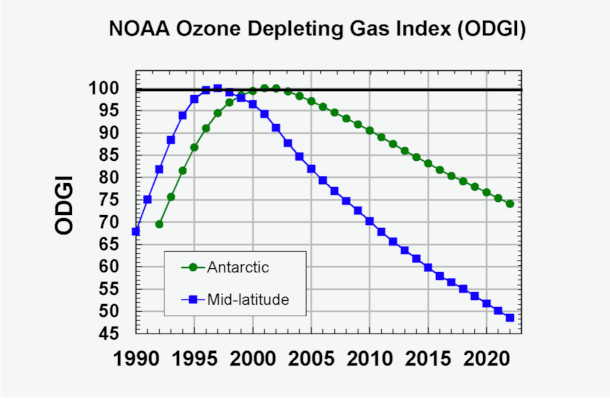
The NOAA Ozone Depleting Gas Index (ODGI) tracks the overall stratospheric concentration of ozone-depleting chlorine and bromine from long-lived ODSs relative to its peak concentration in the early 1990s. Relative to that peak, ODS concentrations have decreased by 25%in the Antarctic, and by 50% over midlatitudes. (Photo: Courtesy of NOAA Global Monitoring Laboratory)
CURWOOD: As the world gathers in Egypt at the COP27 climate summit, another international treaty cast from the same mold is yielding positive results. Emissions of chemicals that tear holes the upper-level atmospheric ozone layer have been drastically reduced, thanks to the Vienna Convention launched in 1985 and its related Montreal and Kigali protocols. The treaty phases out synthetic chemicals including refrigerants that deplete ozone, a form of oxygen that protects life on earth by filtering harmful ultraviolet rays. It takes time to change the chemistry of our entire atmosphere, but now nearly 40 years after the world started tackling the problem there is resounding success. NOAA recently reported that the midlatitude concentrations of ozone depleting chemicals have declined by 50% compared to peak historic levels. And near the South Pole, they’re down by 25 percent. For more I’m joined now by Steve Montzka, he’s a senior scientist for NOAA’s Global Monitoring Lab. Steve, welcome to Living on Earth!
MONTZKA: It's nice to be with you, Steve.
CURWOOD: So at this present rate of getting back to the pre-ozone depletion levels, how long do you think it will take us to get there?
MONTZKA: Every four years, the science community comes together to inform the Parties to the Montreal Protocol about the state of the science. And the latest report is just about to come out. And it still looks like that ozone layer will return to pre-ozone hole conditions sometime in the middle of the 21st century, 2050, 2060. Around that era.
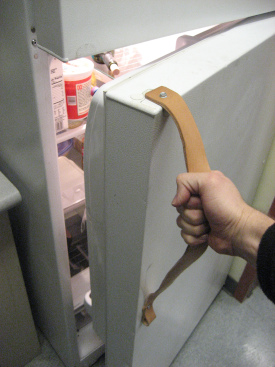
Chlorofluorocarbons, or CFCs, were widely used as refrigerants until the 1980s. CFCs are considered an ozone-depleting substance and a greenhouse gas. (Photo: switthoft, Flickr, CC BY 2.0)
CURWOOD: Now, there was a process that the world went through to deal with ozone depleting chemicals. First Vienna, and then the Montreal Protocol. And countries agreed, of course, to reduce the use of these chemicals. So what do you think was key though, for compliance? What is it that encouraged nations and companies to comply with the Montreal Protocol? There's not exactly an ozone cop out there.
MONTZKA: No, that's true. I think of a few things that caused folks to really pay attention to this issue. I think we have to remember that the ozone layer itself is critical for life on Earth to exist as we know it today. And so, in 1985, when Joe Farman and his colleagues indicated that, “Oh, my goodness, ozone in the stratosphere, over Antarctica was dropping like a rock,” people stood up and noticed, and began to really wonder about what they could do. I think when I listened to recordings of scientists and policymakers from the 1980s, after that announcement was made, I hear the fear in their voice. You know, the concern was that we were looking at the proverbial dead canary in the atmosphere, that ozone was dropping precipitously. And it was because of actions and emissions that humans had produced. It was because of things that we were doing. And so they stood up, took notice and took action. I think the other thing that made a difference was that the actions that were taken initially were only small steps. Policymakers acted rapidly, but only incrementally. You know, the 1987 Montreal Protocol by itself wouldn't have resulted in the eventual healing of the ozone layer. But through this iterative process, where the policymakers get together, decide what they can agree on, and then going to the scientists for input and updates and further understanding improvements in our understanding of the issue itself, and then coming back together as policymakers to decide whether or not they needed to strengthen the Protocol, or possibly weaken it, as a result of the new information. We've had amendments to the protocol over time that eventually resulted in CFCs and other ozone depleting gases being banned. And countries abiding by those bands for the most part.
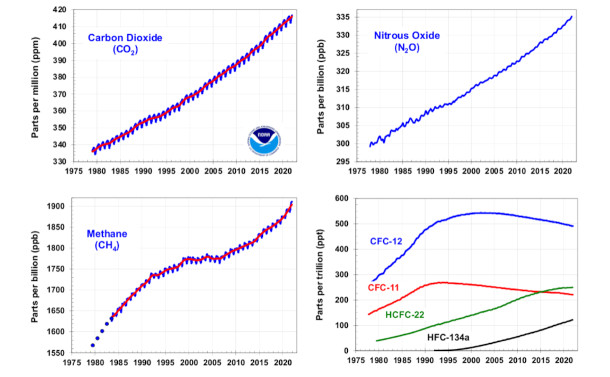
The concentrations of ozone-depleting substances have decreased over time since the 1990s. However, NOAA’s research shows that global concentrations of other greenhouse gases, such as carbon dioxide, nitrous oxide, and methane, continue to increase. (Photo: Courtesy of NOAA Global Monitoring Laboratory)
CURWOOD: So the trend is going in the right direction. What do you think needs to be done on a broader scale to maintain this downward trend? What does the global community need to do to keep countries and companies, dare we say, in line when it comes to regulating ozone depleting substances?
MONTZKA: Well, Steve, I think we need to look at the recent past to understand what's worked. I think it's been a process of the Parties to the Protocol meeting regularly to assess the science and the new information that's being provided to understand whether or not changes in the ozone layer are happening as expected. Those parties still meet two times per year to assess these considerations. You know, it was only a few years ago, when we noted that CFC11, a few years after global production was supposedly banned, we saw CFC11, its concentration, decline more slowly over time. In fact, we could infer that emissions of CFC11 were increasing, started increasing a few years after the production was banned globally, which was quite a surprise. But it turned out it really seemed like somebody was violating the Protocol.
CURWOOD: Uh oh.
MONTZKA: And the year after we raised the flag to suggest that, “Goodness, things aren't changing, as expected, and it really looks like somebody may be producing and using this chemical again,” some measurements made downwind of that region really pinpointed the location. And you know what, Steve, since that time—that was mid 2018—the concentration decline of CFC11's been rapidly accelerating, which is great to see.
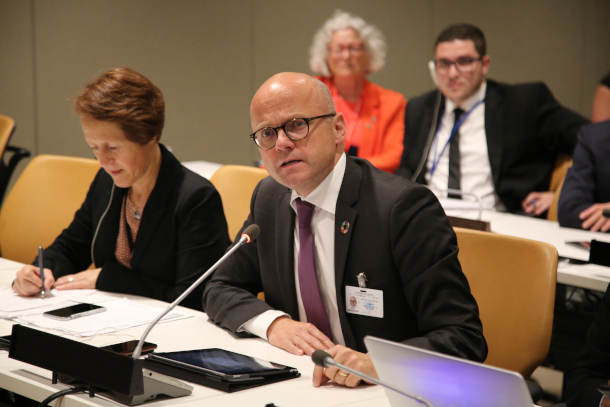
The 1987 Montreal Protocol of the Vienna Convention successfully phased out global production and consumption of ozone-depleting substances. Parties to the Protocol still meet twice a year to assess the science and propose amendments. Shown here is Vidar Helgesen, Norway's Minister of Climate and the Environment in 2017. (Photo: Rwanda's Ministry of Environment, Flickr, CC BY-ND 2.0)
CURWOOD: What was the region that seemed to be the source?
MONTZKA: My initial study suggested that it was emissions from Eastern Asia, and then the subsequent study was able to determine that it appeared to be that emissions were increasing in an unexpected way from Eastern China.
CURWOOD: So the success of what you say is an iterative process, how might that be applied to climate disruption? Because like discovery of the ozone hole, science has been sounding the alarm about the release of climate-changing gases and the road that we're on right now if we don't effectively address it. And so far, we're not there in terms of reining in climate disruption.
MONTZKA: Yeah, it's clear that the trajectories of greenhouse gases haven't turned over like they have for ozone depleting substances. Greenhouse gas concentrations are still increasing rapidly in the atmosphere, and at this point more rapidly than they have, you know, over the past 100 years or more. So what will it take? I'm not sure, there is a process in place that provides feedback. And so the state of the science is there for folks to see. But the issue is perhaps much more complicated, and has many more players involved, then the issue of ozone depletion.
CURWOOD: For example?
MONTZKA: Well, when we're talking about ozone depleting substances, there were a limited number of companies around the world that produced these chemicals. And I think, when the issue of ozone depletion arose, they ultimately decided that they were able to make some substitutes that were less threatening to the ozone layer. So maybe you had an industry down the street or in a in a town that initially created CFCs. But they could retool to make the substitutes. And so it was, perhaps I won't say an easy transition for them, but one that didn't cause huge disruptions in the locations of industries and the employment of local communities and things like that. Whereas when we're talking about climate change, and all the different industries involved in supplying energy, the problem seems much more complex.
CURWOOD: Steve Montzka is a senior scientist for NOAA'S Global Monitoring Lab. Thanks for talking with us.
MONTZKA: Steve, it was very nice talking with you.
Related links:
- NOAA | “Path to recovery of ozone layer passes a significant milestone”
- NOAA | “Antarctic ozone slightly smaller in 2022”
- UNEP | “About Montreal Protocol”
- NOAA | “The NOAA Annual Greenhouse Gas Index”
[MUSIC: Clifford Brown, Max Roach Quintet, “Sandu” on Study In Brown, UMG Recordings]
CURWOOD: Coming up – how to stop losing wildlife. Keep listening on Living on Earth.
ANNOUNCER: Funding for Living on Earth comes from you, our listeners, and United Technologies, combining passion for science with engineering to create solutions designed for sustainability in aerospace, building industries, and food refrigeration.
[CUTAWAY MUSIC: Clifford Brown, Max Roach Quintet, “Sandu” on Study In Brown, UMG Recordings]
Extreme Wildlife Loss

Sea turtles in Palawan, the Philippines. (Photo: David Reynolds, Unsplash, public domain)
CURWOOD: It’s Living on Earth, I’m Steve Curwood.
The latest Living Planet Report from the World Wildlife Fund and Zoological Society of London documents a nearly seventy percent depletion of wild animals with backbones over just the past 50 years. The report comes as the UN Convention on Biological Diversity prepares for its fifteenth conference of its parties or COP in Montreal, Canada at the beginning of December. So, for the story behind this alarming assessment of wildlife loss we turn now to one of the report’s authors, Jeff Opperman, the global lead scientist for freshwater for the World Wildlife Fund. Welcome to Living on Earth Jeff!
OPPERMAN: Great, thanks. It's great to be here and really looking forward to talking about this important topic and what we can do about it.
CURWOOD: So, Jeff Opperman, tell us your findings in this year's Living Planet Report. How different is it from the report of two years ago?
OPPERMAN: Well, the headline finding is that there's been a 69% decline in monitored vertebrate populations of wildlife. So vertebrates are mammals, birds, reptiles, fish, amphibians. The Living Planet Report includes what's called the Living Planet Index. And that is 32,000 distinct populations of vertebrates that have been monitored for their abundance over time. These are drawn from across 5,000 different species, and it combines them into a number that reflects the overall trend, the overall pattern of wildlife on Earth.
CURWOOD: And over what period of time are we talking about losing this 69%?
OPPERMAN: So the LPI, that Living Planet Index, number of a 69% average decline is from 1970 until 2018. There's a little bit of a lag in the data so that what we release this year, it goes up to 2018. It's about 50 years. You know, I was born in 1971. This number is reflecting the trend since 1970. So basically, just in the time that I've been on Earth, the Earth has seen this average decline of about two thirds of these wildlife populations.
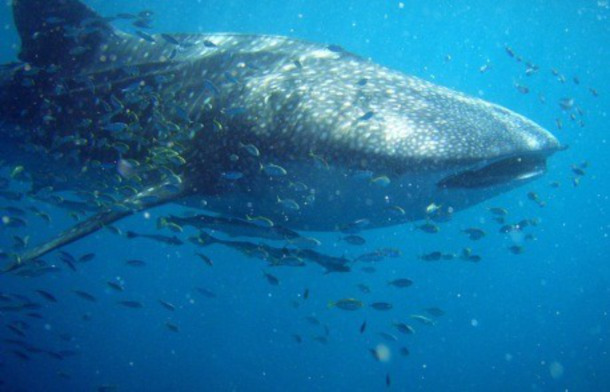
A whale shark as photographed in Ningaloo Reef in Australia. (Photo: brittgow, Flickr, CC-NC 2.0)
CURWOOD: And we're talking about things with backbones, from fish to deer to birds, but not insects, which I guess are also seeing a fairly substantial decline.
OPPERMAN: A lot of it has to do with the fact that it's a monumental task of integrating all these datasets. As I said, 32,000 distinct populations and integrating them to try to see these trends over time, and to fill in the gaps and to recognize what types of species we have fewer data from what regions, you know. Until recently, we had a lot less data from South America, and we've been working to fill that gap. The problem with insects is, rather than filling gaps, it would be mostly gaps. We just simply don't have the same degree of tracking over time of insect abundance. The studies that have been done in specific areas are quite alarming. And I do think that the scientists who manage this Living Planet Index are trying to collect insect data to do it in the same way.
CURWOOD: So you're talking about, for lack of a more elegant word, the biomass of the wildlife population? To what extent is this related to extinction?
OPPERMAN: The real data that we're talking about here is abundance of populations. If you were monitoring a population of whale sharks in the Caribbean, and there were 8,000 of them in 1980, and then there were 4,000 of them in 1990, that those would be data points that could go into the Living Planet Index, because it would be a population of whale sharks, and that would be one of the 30,000. And then there could be another population of whale sharks in the Indian Ocean, also tracking the abundance. So the real essence of the LPI is to take all those abundance, which also reflect biomass and just how many animals are out there in these different populations. Now, it's not quite the same thing as extinction. Extinction is fairly binary. And there are indices that track extinction or ways of tracking the number of species have gone extinct. But as I just said, that is very binary: a species is either still around or goes away, in terms of being an indicator. In some ways, it's not very useful indicator, because once a species is extinct, that's it. It's better to be tracking the status of species, the status of populations, are they declining. And of course, continued rapid decline is what precedes extinction. So they are related. But the abundance of the LPI, the Living Planet Index, does allow us to be looking at it much more like a dashboard, giving us useful information, and allowing us to respond.
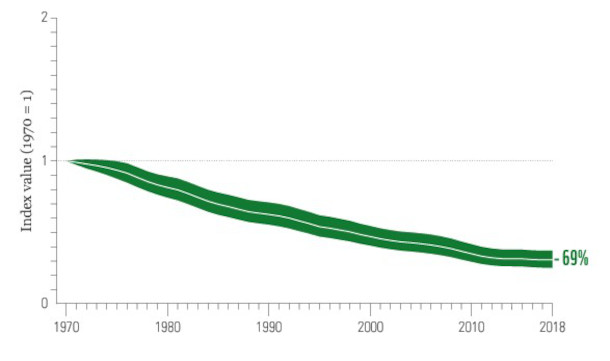
The global Living Planet Index shows the average 69% decline in relative abundance of nearly 32,000 populations of more than 5,000 species across the globe. (Photo: Courtesy of WWF/ZSL)
CURWOOD: So if over the last 50 years, roughly, we've lost close to 70% of the population of wildlife. This also tracks the period of time that we've seen climate disruption really emerge in a rather rapid way. What relationship is there, do you think, between climate disruption and this loss of wildlife population over the last 50 years?
OPPERMAN: My answer to that might seem like a contrary because the first thing I'm going to say is that thus far, climate change is not been one of the major drivers of decline. So the major drivers of decline have been habitat loss and degradation, hunting or overharvest, pollution, invasive species. Those have been the primary drivers, the very big forces that have been causing these declines. Climate change is just beginning to be detected as something that is contributing. Now, going forward, scientists are predicting that if we do not hit our climate targets, which keeping the warming to 2 degrees Celsius, or one point, even better, 1.5 degrees Celsius, that if we exceed those boundaries, that climate change will become one of the leading drivers. So it's going to be added on top of the habitat loss and degradation and pollution etc. And that's because, you know, species have a range of temperature. Imagine, you know, plants and insects in a very specific temperature ranges or fish in water bodies, very specific ranges of temperature that they can tolerate, and they will move around to try to find the right temperature or the right amount of water. Well, climate change will be driving changes in temperature and water. And so the habitat conditions that are appropriate for species are going to be moving and shifting. And they will need to be trying to move and shift with those habitat changes. But in a world that's quite fragmented, it's going to be with roads and population agriculture, it's gonna be very hard for species to move. And that's why scientists think that if the climate changes that much and the habitat envelope of what's appropriate is shifting, species are gonna essentially have the habitat just move away from them. And there will be a lot more losses because of that.
CURWOOD: So as you say, we're just starting to see the effects of climate disruption on wildlife populations. But what is the relationship between climate disruption and this loss of numbers of wildlife? How are they connected?
OPPERMAN: One major point that the report does make is that the climate crisis, the nature crisis are two sides of the same coin. And that's because many of the same drivers of one are also driver of the other. So take the loss of tropical forests. As tropical forests are being cleared, they're releasing huge amounts of carbon. And deforestation is one of the big contributors to greenhouse gases. And so the climate crisis. Tropical forests also host the most species of really any ecosystem type. And so the loss of tropical forests is also driving the nature crisis. So two sides of the same coin in terms of the drivers of the crisis, but also two sides of the same coin in terms of solutions, that if we can protect and restore tropical forests, we can be addressing both the nature crisis and the climate crisis.
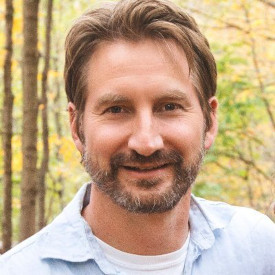
Jeff Opperman, WWF Global Freshwater Lead Scientist. (Photo: Courtesy of Jeff Opperman)
CURWOOD: Jeff, how alarmed should we be by your report? That we've lost over the 50 years, 70% or so of the wildlife population? I mean, if you look at that trend in another 50 years, I mean, what are we going to have left?
OPPERMAN: Yes, 69% decline is alarming. It's a staggering loss. It's an indicator that we are not managing the life support systems on Earth that we really all depend upon. And as I said, it's related to the climate crisis, the same losses of nature and wildlife are driving a lot of the problems that we're going to be having in terms of water and forest fires and floods. I mean, things that are really affecting people's health and safety. So that is alarming. The indicator, the dashboard light is blinking red. But the good thing is we know how to pull off and get service and we can address that dashboard light. And, you know, another big point that the report makes is while conservation is critical, and when I say conservation, I mean what people typically think of conservation organizations like World Wildlife Fund doing, that's critical, but it's only one small part of what we need to do. What we really need is a whole of society approach, transforming the way we grow food, transforming the way we produce energy. That's what we're going to need to actually reverse this nature crisis.
CURWOOD: Jeff, some scientists criticize the way that the Living Planet Index represents a global trend of wildlife population. What do you have to say to those critics?
OPPERMAN: Well, if the criticism is that it's a single number, and it's overly simplistic, I mean, one response to that is that yes, there is the headline number, the negative 69% average decline globally, for vertebrates. But that statistic can be calculated at many different scales. So actually, you can go into the data and the data are publicly available. And you can extract LPI statistics, you know, changes average changes in abundance at the level of a continent. You can look at North America or Asia or for a major habitat types. So you can look at all species that live on land or live in the oceans or depend on freshwater systems like lakes and rivers. Or you can look at a major group like migratory fish. So there's a lot of subtlety and nuance that you can extract from the same data. Now, the reason for that headlines, the global LPI statistic, is its simplicity. So if that's the criticism, you know, that it's overly simplistic, it's also its strength. The simplicity of having a number that reflects the overall performance of the overall trend in wildlife is really powerful. And it does generate attention. And attention is absolutely crucial if we're going to actually begin to address this crisis.
CURWOOD: Jeff, this report is daunting to say the least. Tell me about the good news that's in it and what people can do if they're concerned in response to this report.
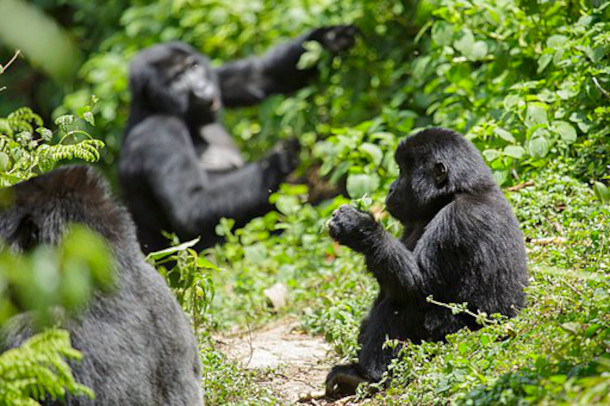
Mountain gorilla living within Bwindi Impenetrable National Park in Uganda. (Photo: Thomas Fuhrmann, Wikimedia Commons, CC BY-SA 4.0)
OPPERMAN: So yeah, so I'm really glad you asked this, because the major headline that gets so much attention is daunting. Or let's say the major headline that gets attention is negative: It's a decline, it's loss, negative 69% of wildlife, it's very alarming. And then immediately, you think, well, addressing this is going to be daunting, it's going to be very, very hard. But within that, first of all, there's lots of good stories. I mean, just like, the LPI is like a stock index, like the S&P 500. So it condenses it down to a single number that is the S&P 500 that shows the performance of the market over time, there could be stocks going up, stocks going down, but it condense it to a single number. Well same with the LPI. And even though the overall trend has been negative, there are lots of examples of recovery and populations that are growing. For example, that were sea turtles in a particular part of Cyprus that are up 500%. So there's really good indicators of recovery, that if you look into the data. Including really positive signs, such as where communities are directly invested in conservation projects, and more communities see the benefit, we're seeing positive recovery, like mountain gorillas in certain parts of Africa. Another really positive sign is that much of the land that is managed, owned and managed by indigenous people is showing better results. So satellite studies of the Amazon show that the lands managed by indigenous people and owned by indigenous people tend to have much less deforestation than other lands. And indigenous people manage and own about 20% of the Earth. So they're, ensuring that indigenous people have the rights to manage and own their own land can also be very positive for nature. And then, you know, the daunting thing is that we need to when I say we need to transform the way we grow food and transform the way we produce energy. Well, what's not so daunting is that the energy transformation is well underway. And I think it's a real sign that this whole of society approach is not a pipe dream. It's actually happening. Energy systems are being transformed as we speak. Seventy percent of all new electricity generation each year is now wind and solar. The cost of solar has dropped 90% in a decade. This is so much faster than energy people thought was going to happen. And it really arose through this whole of society approach to coming up with a more sustainable energy system.
CURWOOD: Jeff Opperman is the World Wildlife Fund global lead scientist for freshwater. Jeff, thanks so much for taking the time with us today.
OPPERMAN: Thank you so much. It was really great to talk with you about this report, but also what we can do to bend the curve and reverse this loss of nature.
CURWOOD: For all its 30 years of existence the United Nations convention on Biological diversity has yet to set hard targets for nations to achieve wildlife protection. Many hope this year’s session will lead to concrete Nature Positive goals rather than vague promises to restore wildlife. For example, ninety percent of the wildlife in South America has been lost, so if the world agrees to provide adequate resources to protect tropical forests and shift to renewable energy, such commitments will help restore wildlife and stabilize the climate at the same time.
Related links:
- Click here to read this year’s Living Planet Report
- Vox | “There’s a frightening new report about wildlife declines. But many are getting the story wrong.”
- Read WWF Canada’s article on why the upcoming United Nations biological diversity convention is important in addressing the nature loss
- Reuters | How Elizabeth Mrema is striving to affect a ‘Paris moment’ for nature
[MUSIC: Ahmad Jamal, “For All We Know” on Happy Moods, Verve Label Group]
CURWOOD: Living on Earth is produced by the World Media Foundation.
Our crew includes Fern Alling, Naomi Arenberg, Bobby Bascomb, Paloma Beltran, Chloe Chen, Iris Chen, Josh Croom, Jenni Doering, Mark Kausch, Kharishar Kahfi, Mark Seth Lender, Don Lyman, Louis Mallison, Aynsley O’Neill, Sophia Pandelidis, Jake Rego, Ashley Soebroto, and Jolanda Omari. We bid a fond farewell to intern Delaney Dryfoos. Tom Tiger engineered our show. Alison Lirish Dean composed our themes. You can hear us anytime at L-O-E dot org, Apple Podcasts and Google Podcasts, and like us, please, on our Facebook page - Living on Earth. We tweet from @livingonearth. And find us on Instagram at livingonearthradio. I’m Steve Curwood. Thanks for listening!
ANNOUNCER: Funding for Living on Earth comes from you, our listeners, and from the University of Massachusetts, Boston, in association with its School for the Environment, developing the next generation of environmental leaders. And from the Grantham Foundation for the protection of the environment, supporting strategic communications and collaboration in solving the world’s most pressing environmental problems.
ANNOUNCER 2: PRX.
Living on Earth wants to hear from you!
Living on Earth
62 Calef Highway, Suite 212
Lee, NH 03861
Telephone: 617-287-4121
E-mail: comments@loe.org
Newsletter [Click here]
Donate to Living on Earth!
Living on Earth is an independent media program and relies entirely on contributions from listeners and institutions supporting public service. Please donate now to preserve an independent environmental voice.
NewsletterLiving on Earth offers a weekly delivery of the show's rundown to your mailbox. Sign up for our newsletter today!
 Sailors For The Sea: Be the change you want to sea.
Sailors For The Sea: Be the change you want to sea.
 The Grantham Foundation for the Protection of the Environment: Committed to protecting and improving the health of the global environment.
The Grantham Foundation for the Protection of the Environment: Committed to protecting and improving the health of the global environment.
 Contribute to Living on Earth and receive, as our gift to you, an archival print of one of Mark Seth Lender's extraordinary wildlife photographs. Follow the link to see Mark's current collection of photographs.
Contribute to Living on Earth and receive, as our gift to you, an archival print of one of Mark Seth Lender's extraordinary wildlife photographs. Follow the link to see Mark's current collection of photographs.
 Buy a signed copy of Mark Seth Lender's book Smeagull the Seagull & support Living on Earth
Buy a signed copy of Mark Seth Lender's book Smeagull the Seagull & support Living on Earth

